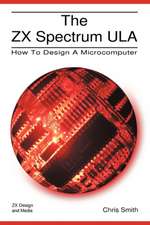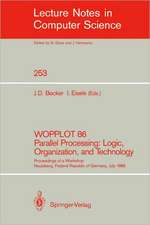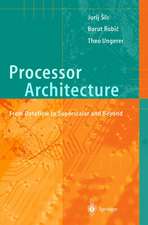Reuse Techniques for VLSI Design
Editat de Ralf Seepold, Arno Kunzmannen Limba Engleză Hardback – 31 mar 1999
Firstly, it sets out the background and support from international organisations that enforce System-on-a-Chip (SoC) design by reuse- oriented methodologies. This overview is followed by a number of technical presentations covering different requirements of the reuse domain. These are presented from different points of view, i.e., IP provider, IP user, designer, isolated reuse, intra-company or inter-company reuse. More general systems or case studies, e.g., metrics, are followed by comprehensive reuse systems, e.g., reuse management systems partly including business models.
Since design reuse must not be restricted to digital components, mixed- signal and analog reuse approaches are also presented. In parallel to the digital domain, this area covers research in reuse database design. Design verification and legal aspects are two important topics that are closely related to the realization of design reuse. These hot topics are covered by presentations that finalize the survey of outstanding research, development and application of design reuse for SoC design. Reuse Techniques for VLSI Design is an invaluable reference for researchers and engineers involved in VLSI/ASIC design.
| Toate formatele și edițiile | Preț | Express |
|---|---|---|
| Paperback (1) | 634.32 lei 6-8 săpt. | |
| Springer Us – 11 oct 2012 | 634.32 lei 6-8 săpt. | |
| Hardback (1) | 640.37 lei 6-8 săpt. | |
| Springer Us – 31 mar 1999 | 640.37 lei 6-8 săpt. |
Preț: 640.37 lei
Preț vechi: 753.39 lei
-15% Nou
Puncte Express: 961
Preț estimativ în valută:
122.53€ • 128.28$ • 101.39£
122.53€ • 128.28$ • 101.39£
Carte tipărită la comandă
Livrare economică 05-19 aprilie
Preluare comenzi: 021 569.72.76
Specificații
ISBN-13: 9780792384762
ISBN-10: 0792384768
Pagini: 153
Ilustrații: XIV, 153 p.
Dimensiuni: 155 x 235 x 11 mm
Greutate: 0.42 kg
Ediția:1999
Editura: Springer Us
Colecția Springer
Locul publicării:New York, NY, United States
ISBN-10: 0792384768
Pagini: 153
Ilustrații: XIV, 153 p.
Dimensiuni: 155 x 235 x 11 mm
Greutate: 0.42 kg
Ediția:1999
Editura: Springer Us
Colecția Springer
Locul publicării:New York, NY, United States
Public țintă
ResearchCuprins
1 ECSI, VSIA and MEDEA — How International Organisations Support Reusability.- 1.1 Abstract.- 1.2 The System-on-a-chip Challenge.- 1.3 ECSI — The European CAD Standardisation Initiative.- 1.4 VSIA — The Virtual Socket Interface Alliance.- 1.5 MEDEA — The Eureka Project on Micro-Electronic Development for European Applications.- 2 Analyzing The Cost of Design for Reuse.- 2.1 Abstract.- 2.2 Introduction.- 2.3 Case Study: ATM Shaper Design.- 2.4 Specific and Reusable Blocks.- 2.5 Comparing Reusable and Specific Components.- 2.6 Conclusion.- 3 A Flexible Classification Model for Reuse of Virtual Components.- 3.1 Introduction.- 3.2 Objective.- 3.3 State of the Art.- 3.4 RMS Similarity Metric.- 3.5 The RMS-Taxonomy.- 3.6 Extended RMS-Classification.- 3.7 Implementation.- 3.8 Application of the Model.- 3.9 Conclusion and Outlook.- 4 An Integrated Approach Towards a Corporate Design Reuse Strategy.- 4.1 Introduction.- 4.2 Why is Design Reuse Difficult?.- 4.3 Core Supply Process.- 4.4 Organization.- 4.5 Business Models.- 4.6 Ensuring Core Quality.- 4.7 Technical Issues.- 4.8 The Overall Strategy.- 5 Design Methodology for IP Providers.- 5.1 How to Become an IP Vendor.- 5.2 IP Database Structure.- 5.3 Documentation of IP.- 5.4 Simulation Testbench Philosophy.- 5.5 Release Management.- 5.6 Dual Language DesignObjects.- 5.7 Scalable DesignObjects.- 5.8 Experience from Reuse Projects.- 5.9 Conclusions.- 6 Hard IP Reuse Methodology for Embedded Cores.- 6.1 Introduction.- 6.2 Simulation Model Generation.- 6.3 StarterKit Simulation Environment.- 6.4 Timing Characterization and Timing Models.- 6.5 Frontend Views and Embedded Core Test Methodologies.- 6.6 Backend Views and Backend Design.- 6.7 IP Repository.- 6.8 Next Steps.- 7 A Reuse Library Approach in Engineering Context.-7.1 Motivation.- 7.2 Project Description and Objectives.- 7.3 Reuse Methodology.- 7.4 Module Administration.- 7.5 Presentation and Access to Modules.- 7.6 Measurement.- 7.7 Summary.- 7.8 Conclusion.- 7.9 Status of the Work.- 7.10 Outlook.- 8 Aspects of Reuse in The Design of Mixed-Signal Systems.- 8.1 Abstract.- 8.2 Introduction.- 8.3 Top-Down Design Flow.- 8.4 Databases and Reuse.- 8.5 Summary.- 9 Design Reuse Experiment for Analog Modules “Dream”.- 9.1 Introduction.- 9.2 Requirements for Reuse of Analog Blocks.- 9.3 Implementation.- 9.4 Experience.- 9.5 Future work.- 9.6 Acknowledgement.- 10 Redesign of An MPEG-2-HDTV Video Decoder Considering Reuse Aspects.- 10.1 Introduction.- 10.2 Design Reuse.- 10.3 Redesign of an MPEG-2-HDTV Video Decoder.- 10.4 Design by Reuse (Inverse Quantiser).- 10.5 Design for Reuse (IDCT — Inverse Discrete Cosine Transform).- 10.6 Summary.- 11 Reuse Concepts in Gropius.- 11.1 Abstract.- 11.2 Introduction.- 11.3 Gropius — a Survey.- 11.4 Design Reuse across Abstraction Levels.- 11.5 Everything can be Abbreviated.- 11.6 Polymorphism.- 11.7 Parameterization with Circuits.- 11.8 Regularity.- 11.9 Strict Separation between Functional and Temporal Aspects.- 11.10 Uniform Communication Protocol at the System Level.- 11.11 Conclusion.- 12 Legal Aspects of Reuse of Intellectual Property.- 12.1 Issues.- 12.2 Legal Situation.- 12.3 Contractual and Technical Remedies.- 13 References.






















